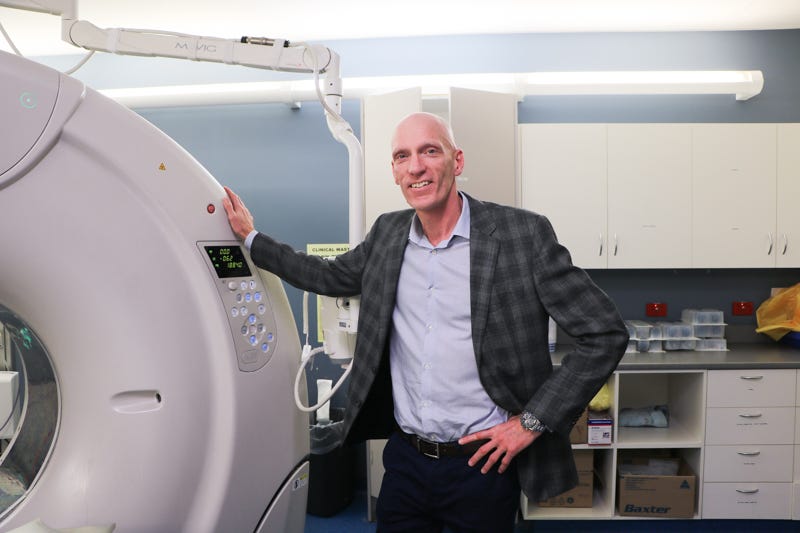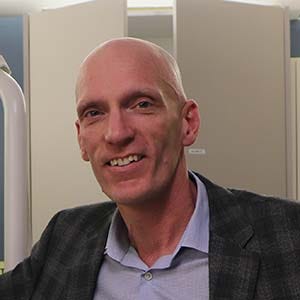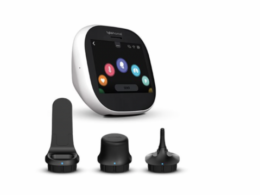Linkedin
Victor Dominello MP
Minister for Customer Service and Digital Government at NSW Government
& Member for Ryde
April 8, 2022
ARTICLE 1
In NSW about 18,000 people present with stroke symptoms each year. Typically a CT scan is required.
There are 2 types of strokes — those caused by bleeds and those caused by clots.
Treatment for clots usually means drugs. Quick administration can save lives/reduce severity of impact.
However the challenge is diagnosis. There are only a handful of highly skilled people — that can read the CT scan and tell the difference between clot/bleed and determine how much of the brain is recoverable.
Telestroke enables the emergency physician to obtain urgent 24/7 advice to ascertain the type of stroke and the best treatment.
Unsurprisingly — AI is also used to assist the specialists ascertain which parts of the brain are recoverable.
Since it started, 360 — is the number of lives saved/enhanced as a result of Telestroke 🙏
Telehealth and virtual healthcare is an area that shows so much promise — to improve quality of life and reduce suffering 🙏
Originally published at https://www.linkedin.com
LINK FOR VIDEO
https://aci.health.nsw.gov.au/statewide-programs/telestroke
ARTICLE 2

Virtual specialists have real impact on rural stroke patients
‘Tele Stroke’ puts a Sydney stroke specialist in the emergency department of a rural hospital to give patients vital early assistance.
UNSW
06 SEP 2021
LACHLAN GILBERT
Stroke specialists in NSW are now helping doctors in regional hospitals to deliver early treatment to stroke patients via tele-link.
Every minute counts when a person has a suspected stroke and nowhere is time more crucial than in regional areas of New South Wales.
Having to travel long distances and a lack of dedicated specialists on the ground can make it hours before a patient receives life-saving treatment.
But an initiative overseen by UNSW Sydney academic staff has cut this time drastically by giving specialists in the city the ability to join patients and rural hospital medical staff in a virtual meeting.
Now stroke patients in regional areas can be diagnosed and administered first-line therapy within an hour.
Professor Ken Butcher is the Director of Clinical Neurosciences at the Prince of Wales Clinical School at UNSW Medicine & Health.
He is also the Director of a new system of treatment for stroke patients dubbed ‘Tele Stroke’ that connects stroke specialists in Sydney with one of 12 regional hospital Emergency Departments (EDs) around NSW, which will grow to 23 by the end of the year.
‘Tele Stroke’ connects stroke specialists in Sydney with one of 12 regional hospital Emergency Departments (EDs) around NSW, which will grow to 23 by the end of the year.
Using high quality cameras, microphones, AI systems, diagnostic scanning and imaging tools all streaming in real time over a high-speed internet connection, specialists and ED registrars can work together to quickly determine whether the patient has had a stroke, and if so, decide on the best medical strategy.
Using high quality cameras, microphones, AI systems, diagnostic scanning and imaging tools all streaming in real time over a high-speed internet connection …
“There are two types of strokes that a person can have,” Prof. Butcher says, “an ischaemic stroke, caused by a blood clot in an artery which accounts for about 85 per cent of all strokes, or a haemorrhagic stroke, which is a rupture of a vessel in or around the brain.
“From the outside these two may look the same — a person all of a sudden can’t move part of their body or can’t talk.
“But it’s only when we do a scan that we can work out which type of stroke someone’s having, and this analysis can now be done while the patient is still in the ED of the regional hospital, rather than hours later in Sydney.”
Prof. Butcher says after using Tele Stroke to assess and treat more 1000 patients from regional NSW in the past 12 months, the average time it has taken for a patient to receive potentially life-saving treatment is down to 66 minutes.
“In the past, if someone presented at a regional hospital with stroke-like symptoms, the ED would do a scan and call one of the neuroradiologist doctors in Sydney and then wait for them to tell what the scan shows.
“Then, if necessary, the patient might be airlifted to Sydney — so it could be hours before they get any sort of medical intervention.
“Now the ED doesn’t have to wait for a neuroradiologist in Sydney to make their report. We have a specialist stroke-trained doctor virtually there in the ED room with the doctor and patient.
They can see us, we can see them. We can talk to them and know exactly what we’re dealing with — it’s no longer a description over the phone.”

Professor Ken Butcher (UNSW, Prince of Wales Hospital) and fellow Tele Stroke consultant Dr Timothy Ang (Royal Prince Alfred Hospital). Photo: Ken Butcher
From research concept to standard tool
Prof. Butcher says it may well turn out that the patient does need transporting to Sydney to see a neuro-interventional radiologist who can remove a blood clot. But in the meantime, the ED can administer some clot-busting drugs that buy the patient valuable time.
Before making the call to bring in the Tele Stroke specialists, the ED doctor enters the patient’s details and symptoms into an online diagnostic tool which provides guidance on next steps in the process. Ringing a 1300 number will connect the ED room with one of nine specialists who collectively are on-call, 24/7.
“In most cases, once the ED registrar has contacted us, the patient is sent for scans and we meet the patient and the physician virtually in the scanning room, and assess the images as they’re taken,” Prof. Butcher says.
Three different scans are taken of the patient using a CT-scanner. The first is a non-contrast CT scan of the patient’s brain which can determine the type of stroke the patient has, but does not show where the occlusion — or blockage — might be.
“When I started my career we would just use a non-contrast CT scan in the early stages of diagnosing a stroke, and we would have to guess where the occlusion might be,” Prof. Butcher says.
“But now we add to that a CT angiogram — where we inject dye to allow us to see blood vessels both in the neck and the brain. And finally, we do a perfusion scan which will give us a map of regional blood flow.
“Using these three scans together tells us a lot more about where the stroke is occurring and how we can treat it.”
Prof. Butcher says Australia leads the world in streamlining these different technologies — particularly perfusion imaging — into stroke treatment.
“A lot of people around the world would argue angiogram scans and perfusion scans are for research. But we say in this setting where every minute counts, these scans are critical. We’ve taken what was a research concept and made it a standard tool.”
But as it turns out, because the system hinges on digital technology, much of the data collected — including scan images, diagnostic tools and time to first treatment — can be later used in research after all.
Prof. Butcher says not only can Tele Stroke include patients in prospective research — such as a clinical trial of a new thrombolytic drug currently being led by UNSW Professor Mark Parsons — but the model is also ideal for retrospective research, especially after he insisted on archiving all source image data.
“If you set up a platform like this, which benefits patients, it also benefits researchers, because you’re collecting the same data in the same fashion all the time, including outcomes. Also, retrospectively, you can see in real time what we’re accomplishing, where the problems are.”
He says he expects to release a research paper later this year that will provide a detailed analysis of the Tele Stroke system in its first 12 months.
Originally published at https://newsroom.unsw.edu.au
Names mentioned
Professor Ken Butcher is the Director of Clinical Neurosciences at the Prince of Wales Clinical School at UNSW Medicine & Health.
Tele Stroke consultant Dr Timothy Ang (Royal Prince Alfred Hospital)
ARTICLE 3

Developing a world-leading telestroke service
ACI Health
By Professor Ken Butcher
27 Apr 2021
Professor Ken Butcher, Medical Director of the NSW Telestroke Service, reflects on how a popular concept has become a world-leading, life-saving service to rural and regional NSW.
Stroke is the third most common cause of death and the leading cause of adult disability in Australia. It was once thought to be untreatable; however, developments over the last two decades have transformed our approach to acute stroke.
The most common type of stroke occurs when a blood clot blocks an artery. We can now remove the clot using thrombolysis, where the clot is broken down using a specific medicine, and/or endovascular clot retrieval (ECR), where the clot is removed using suction. However, these therapies can only be given after careful patient selection criteria have been met.
The complexity of acute stroke management has resulted in sub-specialties within neurology, interventional neuroradiology and other areas. Systems of care are evolving in urban areas to direct patients with a suspected stroke to centres with these sub-specialty services; however, this approach is not feasible in rural and remote areas in NSW. This is a clinical problem that lends itself particularly well to a telehealth solution.
Adopting a telehealth solution
Telestroke is not a new concept and has been part of my career in Australia and Canada for more than a decade. In principle, the concept is straightforward — bring sub-specialist stroke care to rural and remote hospital settings using telehealth technology.
A functioning telestroke service requires:
- brain imaging to be performed at the primary (referring) hospital
- a technology platform that allows rapid viewing and interpretation of the brain images immediately after they are acquired
- some form of audio-video communication link between the specialist, referring physicians and patient (I have used everything from a telephone to dedicated medical communication equipment in the past).
Most telestroke services around the world, including ours in NSW, have grown organically through small physician-initiated pilot projects.
While these projects are critical to demonstrating the ‘proof of concept’, in most cases they are not sustainable due to the increasing workload and lack of infrastructure support.
The individuals who have dedicated their time to this service are too numerous to name, but each of you has my gratitude and admiration.
The NSW Telestroke Service
Establishing a statewide NSW Telestroke service was an election commitment of the NSW Government in March 2019. The $21.7 million service is jointly funded by the NSW and Commonwealth Governments.
The service offers people living in regional and rural areas increased access to life-saving stroke diagnosis and treatment. This is done by connecting local doctors to specialist stroke physicians, via video consultation in the emergency department.
Over the last year, the service has grown from two to eight sites, with another 15 coming online by June 2022.
In my view, there are some key commitments to the NSW Telestroke Service, including those by the Agency for Clinical Innovation (ACI), that have made this a world-leading service.
Stewardship and governance leadership
The visioning of this service was developed within the Ministry of Health and the Agency for Clinical Innovation.
It was recognised early on that this needed to be a dedicated clinical service and that specialist stroke physicians needed to be focused on the task, rather than doing this ‘on the side’ while looking after patients in their own hospitals.
In NSW, there is a small but dedicated group of stroke specialists, many who are working with the Telestroke Service. This group was consulted before the establishment of the service and after the service started operation. The commitment of this group has been refreshing. In addition, the Ministry of Health recognised this service was outside the scope of current local health districts services and established the appropriate level of infrastructure support, based at the Prince of Wales Hospital.
Infrastructure support
One of the service’s core principles is that primary referral sites must meet a minimum standard for performing imaging and brain scans, including offering full multi-modal computed tomographic (CT) scans. This decision has ensured that the correct diagnosis can be made rapidly and accurately, allowing the correct patients to be treated using telestroke technology.
I have been impressed by the efforts of the eHealth NSW team, who have very quickly become experts in CT scanning and image transfer. eHealth has also built a patient communications platform, by leveraging existing infrastructure such as workstations on wheels and Skype. This pragmatic decision allowed us to rapidly deploy a scalable telestroke solution that can be updated easily and frequently.
Training and support
The efforts of the ACI staff in this area cannot be over-stated. In most telehealth scenarios, specialist physicians encounter primary care staff who have little familiarity with the service provided — its goals, capabilities or procedures. For the NSW Telestroke Service, the ACI have provided exemplary training and capacity building to primary stroke site medical, nursing, allied health, technical and administrative staff. The level of support ACI has provided is unparalleled, including multiple on-site visits, simulations, support for data collection, and liaison with the Ministry of Health and local site.
Local support
None of this would be possible without the enthusiasm and commitment of staff at the primary referring sites. The initiative demonstrated by staff in overcoming all manner of barriers has been incredible to watch.
The NSW Telestroke Service has been one of the most gratifying projects I have been involved with in my career. The leadership at all levels, from the Minister of Health to frontline staff in rural emergency departments, must be commended. The individuals who have dedicated their time to this service are too numerous to name, but each of you has my gratitude and admiration.
Did you know?
- The NSW Telestroke Service is built on a foundation of pilot work. ACI Stroke Network clinicians worked with Hunter New England and Mid North Coast Local Health Districts in 2017–18 to pilot a telestroke program.
- ACI partnered with eHealth NSW and the Ministry of Health to structure a state-based approach to scaling the service.
- Implementation is a collaboration between the Prince of Wales Hospital, eHealth NSW, the Agency for Clinical Innovation and the Ministry of Health.
- The service is managed by the Prince of Wales Hospital, based on the ACI Stroke Network Telestroke model of care developed by the Telestroke and Reperfusion Working Group, in collaboration with proof-of-concept sites.
- The first telestroke sites to go-live were in Port Macquarie and Coffs Harbour in March 2020. The service most recently went live at Grafton Base Hospital, with Griffith close to follow.
- At local sites, many areas across the hospital come together with the Telestroke specialist to provide treatment. “This teamwork and the NSW Telestroke Service allows us to provide treatment locally that wouldn’t otherwise be possible,” says Donna Jay, Stroke Clinical Nurse Consultant in Illawarra Shoalhaven Local Health District.
- In April 2021, Telestroke celebrated treating more than 600 patients.
About Professor Ken Butcher

Professor Ken Butcher is the Medical Director of the NSW Telestroke Service at Prince of Wales Hospital. He is also the Director of Clinical Neurosciences at the Prince of Wales Clinical School at the University of New South Wales and is supported by a NSW Health Senior Cardiovascular Scientist award. He is a clinician scientist who has dedicated his career to improving treatment and outcomes in stroke patients.
Prior to relocating to Sydney, he was a tenured Professor at the University of Alberta and held a Canada Research Chair in cerebrovascular disease. He has held continuous salary and grant-in-aid funding related to stroke research since 2006 and has more than 180 peer reviewed publications












